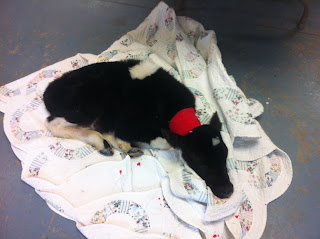One of the things I love about my job is that, most of the time, I'm working with healthy animals and trying to keep them healthy. Working on the "herd level" is challenging and stimulating and takes skills both with animals and people. In fact, herd health work is often more about people and people management than it is about animals.
That said, no one becomes a veterinarian without a love for animals and I'm certainly no different. Helping an animal feel better, reduce her pain or enable her to get back to her job making milk is at the core of what I love about being a vet. That brings us to today's adventure with Petunia.
 |
| Petunia keeping my office manager company |
This is Petunia. She was born a little over a week ago in a barn in Colchester, Vermont. Petunia was born prematurely and weighed less than 30 pounds at birth (normally a Holstein calf is 70 - 90 pounds). My associate Annie adopted her when the farmer who owns her mom wasn't able to provide the intensive care a premie would require. Annie hopes to add Petunia to her growing menagerie of sheep, barn cats and rescued hound dogs.
Petunia has been a project, to say the least. Some friends of Annie's, who work from home and can watch Petunia throughout the day, have offered to keep Petunia and care for her on their small farm until she is strong enough for Annie to bring home. Petunia has an IV catheter in her neck so she can receive daily IV fluids and has just begun to drink milk in the past few days. So far, she has enjoyed getting to know the geese, sheep, pigs and dogs at her adopted home.
As a precaution, Annie performed a blood test on Petunia to gauge the strength of her organs and check on the status of her immune system. The test results made us suspicious her immune system was immature. We also weren't sure how much colostrum she received at birth - a critical part of a newborn calf's immunity.
This morning Petunia's hosts called worried about her. She had been active early in the morning but later began to become depressed and uninterested in her milk. When we examined her we discovered she had a fever and was a little dehydrated. After a bag of IV fluids with some added energy she perked right up. Still, we were worried about her low blood proteins indicating a lack of immunity. We decided we needed to provide her with additional antibodies by giving her a blood transfusion.
Unlike people and some other animals, each cow has an individual blood type so transfusing blood from one animal to another without testing for blood type is possible as long as you don't transfuse from the same animal twice. We hoped that by drawing blood from a healthy adult cow we could provide antibodies to help protect Petunia from disease right away. One of my large farm clients generously agreed to let me draw some blood from one of his healthy fresh cows for the transfusion. Cow #6024 was standing at the bunk eating hay when I arrived so she volunteered by default. We clipped hair over her jugular vein, scrubbed the site and inserted a needle attached to a bag with solution intended to keep the blood from clotting and quickly filled the bag with 6024's precious gift. Valerie Koenig, a senior veterinary student visiting from Tufts University, was a great help.
 |
| Collecting blood for our transfusion |
When we returned to the office, Valerie and I gave Petunia the blood transfusion through her IV catheter.
Petunia slept the rest of the morning (except when she irrigated my office manager's corner of the office - a result of her IV fluids) but woke up and recognized Heidi when she returned to bring her home. Thanks to 6024's gift Petunia now has a fighting chance and we hope she continues to strengthen over the next few days.


































